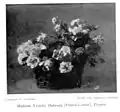Victoria Dubourg
Victoria Dubourg or Victoria Fantin-Latour (1 December 1840 – 30 September 1926) was a French flower painter.
Victoria Dubourg | |
|---|---|
 Portrait of Victoria by her husband | |
| Born | 1 December 1840 |
| Died | 30 September 1926 (aged 85) |
| Nationality | France |
Dubourg was born in Paris and trained with Fanny Chéron, copying old masters such as Willem Kalf in the Louvre.[1] There she met the painter Henri Fantin-Latour, whom she married in 1876. She collaborated with him on floral paintings, but also produced works under her own name that she signed "V Dubourg".[1] Dubourg has been critiqued as an artist whose work lacks originality, simply reproducing the styles of her well known husband.[2] However, a careful review of her early work shows that Dubourg began producing still life two years prior to meeting Fantin-Latour.[3]
Her painting A Basket of Flowers was included in the 1905 book Women Painters of the World.[4]
 A Basket of Flowers
A Basket of Flowers_-_Flowers_-_Google_Art_Project.jpg.webp) Flowers
Flowers Portrait of Victoria by Edgar Degas
Portrait of Victoria by Edgar Degas
References
- Victoria Dubourg in the RKD
- Lesley Stevenson (1997). Gaze, Delia (ed.). Dictionary of women artists. Chicago, Illinois: Fitzroy Dearborn Publishers. p. 468. ISBN 1-884964-21-4.
The Irish Writer George Moore, who had trained as a painter in Paris in the 1870s, examined the issue of sexual difference in his book Modern Painting (1893). He suggested that woman painters have tended to parody men: [they] astonish us as much by their want of originality as they do by their extraordinary powers of assimilation. I am thinking now of the ladies who marry painters, and who, after few years of married life, exhibit work identical in execution with that of their illustrious husbands - Mrs E.M. Ward, Madame Fantin-Latour, Mrs Swan, Mrs Alma-Tadema. In a word, what Manet used to call la peinture a quatre mains.
- Lesley Stevenson (1997). Gaze, Delia (ed.). Dictionary of women artists. Chicago, Illinois: Fitzroy Dearborn Publishers. p. 468. ISBN 1-884964-21-4.
Nor do the facts support Moore's argument. Fantin and Dubourg first met in 1866, when they both belonged to the circle around Manet. Dubourg, however, had produced her first still life two years previously, and Fantin did not exhibit his first still life at the Salon until 1866, so it would appear that Doubourg discovered the genre independently. The two did not marry until 1876, by which time Dubourg had already exhibited still lifes at eight Salons.
- Women painters of the world, from the time of Caterina Vigri, 1413-1463, to Rosa Bonheur and the present day, by Walter Shaw Sparrow, The Art and Life Library, Hodder & Stoughton, 27 Paternoster Row, London, 1905
- 1 painting by or after Victoria Dubourg at the Art UK site
- Victoria Dubourg Fantin-Latour (1840-1926) by Galerie Ary Jan
| Wikimedia Commons has media related to Victoria Dubourg. |